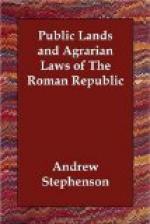Results of this Law. Although Tiberius was dead, yet his law still lived, and, indeed, received added force from the death of its author. The senate killed Gracchus but could not annul his law. The party which was favorable to the distribution of the domain land gained control of affairs. Gaius Gracchus, Marcus Fulvius Flaccus, and Gaius Papirius Carbo, were the chief persons in carrying the law into effect. Mommsen (vol. III, p. 128) says: “The work of resuming and distributing the occupied domain land was prosecuted with zeal and energy; and, in fact, proofs to that effect are not wanting. As early as 622(i.e. from the Foundation of Rome, =132 B.C.) the consul of that year, Publius Popillius, the same who presided over the prosecution of the adherents of Tiberius Gracchus, recorded on a public monument that he was ’the first who had turned the shepherd out of the domains and installed farmers in their stead;’ and tradition otherwise affirms that the distribution extended over all Italy, and that in the formerly existing communities the number of farmers was everywhere augmented—for it was the design of the Sempronian agrarian law to elevate the former class, not by the founding of new communities, but by the strengthening of those already in existence.
“The extent and the comprehensive effect of these distributions are attested by the numerous arrangements in the Roman art of land-measuring referable to the Gracchan assignations of land; for instance, the due placing of boundary stones, so as to obviate future mistakes, appears to have been first suggested by the Gracchan courts for defining boundaries and by the distribution of land.
“But the number on the burgess-rolls gives the clearest evidence. The census, which was published in 623, and actually took place probably in the beginning of 622, yielded not more than 319,000 burgesses capable of bearing arms, whereas six years afterwards (629), in place of the previous falling off (p. 108), the number rises to 395,000, that is 76,000 of an increase beyond all doubt solely in consequence of what the allotment commission did for Roman burgesses.”
Ihne says, concerning this same commission (vol. IV, p. 409): “The triumvirs entered upon their duties under the most unfavorable circumstances.... We may entertain serious doubts whether they or their immediate successors ever got beyond this first stage of their labors, and whether they really accomplished the task of setting up any considerable number of independent freeholders.” Ihne further says (vol. IV, p. 408, n. 1), in answer to the statements made by Mommsen, which we have quoted above: “There is an obvious fallacy in this argument, for how could the assignment of allotments to poor citizens increase the number of citizens? There is nothing to justify the assumption that non-citizens were to share in the benefit of the land-law, and that by receiving allotments they were to be advanced




